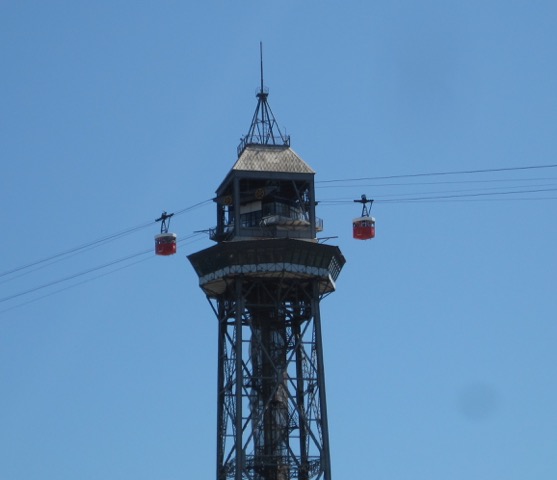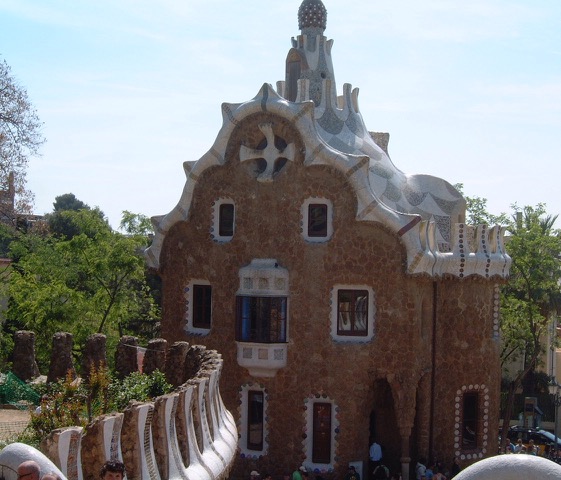BY JANET STEINBERG
Pardon the pun, but here it comes: The reign in Spain is not mainly on the plain. My personal choice for the city that reigns supreme in Spain is Barcelona. So, come along with me to enjoy a taste of Barcelona. Ole!!!
 |
| WELCOME TO BARCELONA |
Catalonia’s capital city of Barcelona, the second largest city in Spain, is surrounded by mountains and the Mediterranean Sea. Montjuïc, the mountain situated between the city and the sea, is one of two mountains that give Barcelona its character.
The name Montjuic, in the Catalan language, means “Mountain of the Jews”. Many Jews owned land on the slopes of this mountain in the 11th and 12th centuries. Stones from the Jewish cemetery, which was abandoned after 1391, can be found in the city’s old Gothic quarter—either scattered on walls of ancient buildings or on display in a special Jewish room in the Historical Museum of Barcelona.
 |
| MONJUIC CABLE CAR |
Overlooking the harbor, the hill of Montjuic was the site of the 1929 World’s Fair and the 1992 Olympic Games. In addition to the Miro´ Museum and the Olympic Ring and Stadium, Montjuic is also the location of Museu d’Art de Catalunya (The Catalonian Museum of Art) and El Poble Espanyol (The Spanish Village). The Catalonian Museum, located in the Palau Nacional, is the home of medieval treasures. To the right of the steps below the Palau is the 1985 reconstruction of the Pavilion designed by Mies van der Rohe for Germany’s exhibit at the 1929 World’s Fair.
The Spanish Village (Poble Espanyol), at the foot of Montjuic, is a complex of full-scale replicas of architectural structures from different regions of Spain. Built as the arts pavilion for the Barcelona World’s Fair in 1929, it is the fourth most visited attraction in Barcelona. The Spanish Village is also home to a plethora of restaurants, shops, cafes, tapas bars and flamenco dancing. Flamenco fever can be caught in clubs or often in concert venues as on Montjuic Hill.
On another mountain overlooking Barcelona (Tibidabo) is the Sagrat Cor church and the adjacent Tibidabo Amusement Park that opened in 1899. The park’s original 1928 Red Aeroplane ride, a single car carousel, will have you feeling like you are flying over the city.
Back on lower ground, Christopher Columbus towers atop a monument at Placa del Portal de la Pau. The more than 150-foot tall Columbus monument (Monument a Colom) stands in the port at the foot of La Rambla, Barcelona’s lively esplanade.
 |
| CHRISTOPHER COLUMBUS OVERSEES THE PORT |
The twisted medieval streets of the ancient Bari Gothic, also known as the Gothic Quarter, was the location of the old Jewish Quarter known as the Call (derived from the Hebrew word kahal meaning community or synagogue). Medieval Barcelona had two Jewish Quarters: Call Mayor, inside the walls, and Call Menor, outside the walls.
In the Gothic Quarter, stroll around to the back of Barcelona’s imposing Cathedral and you will find it was constructed with some interesting building blocks. Scattered throughout the walls are ancient burial stones with Hebrew inscriptions. Nearby, on the wall of the Frederic Mares Museum is the coat of arms of the Inquisition which expelled all Jews from Spain.
Barcelona also offers Museu Picasso and Fundacio´ Joan Miro´. The former, though not the most exciting of the world’s Picasso Museums, is witness to the artist’s connection with Barcelona where he competed his artistic apprenticeship and where he produced his early works.
The Joan Miro´ Foundation, set up in 1971 by Miro´ himself, is devoted to the artist’s work and to the promotion of contemporary art in general. The collection is located in Parc de Montjuic (Montjuic Park).
Visitors from around the world come to Barcelona to follow the ‘Route Gaudi”, an architectural tour of the works of Antonio Gaudi. a pioneer in the Modernist Movement of Architecture.
La Pedrera, one of Gaudi’s later works, exemplifies the inseparability of art and technique. Be sure and visit the roof terrace of the Pedrera where you can observe the skylights and chimneys as well as a grand overview of the city.
 |
| ROOF TOP OF GAUDI’S LA PEDRERA |
Nearby, the Casa Batllo is another Gaudi example of Modernism, the architectural trend of the late 19th and early 20th centuries. It was designated as an historic monument in 1969.
Gaudi’s Temple Expiatori de la Sagrada Familia attracts people of all faiths who flock to Barcelona to visit this “Church of the Sacred Family”. With its surreal spires, said to resemble a melting wedding cake, it was initiated by Gaudi in 1882 and has not as yet been completed. However a group of architects, following Gaudi’s design, have brought the west facade to an advanced stage of construction.
 |
| GAUDI’S SAGRADA FAMILIA |
Between 1900 and 1904, Gaudi built the surrealistic Parc Guell, an architectural extravaganza that has been compared to Dorothy’s “Oz” and Alice’s “Wonderland”. The creative magic of this eccentric architect is exemplified in this park where visitors are greeted by a curvy pink house (Casa-Museu Gaudi), a grinning mosaic frog, and a pavilion that is supported by mushroom-like columns.
 |
| GAUDI’S PARC GUELL |
The 21st century has given birth to some stunning architecture including The Design Museum of Barcelona that serves as the center of Barcelona’s Institute of Culture. The museum is located at the DHUB (Design Hub) building in the Placa De les Glories.
 |
| DESIGN MUSEUM OF BARCELONA Photo Courtesy:Tourist Office of Spain |
The Museum is backdropped by the adjacent rainbow-hued, geyser-shaped Torre Agbar.
 |
| AGBAR TOWER Photo Courtesy: Tourist Office of Spain |
When it’s time for a break from the rigors of touring, sip a soothing Priorato (local red wine) Sangria (red wine, brandy orange juice, fruit) or a bubbling Cava (sparkling wine) in a traditional bodega .
Tapas bars, which started as down-home bars that covered their drinks with tapas (‘lids’ in Spanish) made of meat or cheese to keep the flies off the drinks, have evolved into a dining experience consisting of an entire meal made up of a variety of small dishes.
Restaurants range from elegant to cozy traditional Catalonian restaurants in the Gothic Quarter. One of the most popular Catalan restaurant is Restaurant 7 Portes (7 Doors). That opened in 1836. 7 Doors is the place to taste paella, the national dish of Spain. La Cuina d’en Garriga, the family-owned (since 1876) restaurant/gourmet grocery store, is known for its old-time Catalan feeling when dining.
JANET STEINBERG is the winner of 41 national Travel Writer Awards
